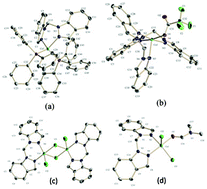Group 11 complexes with the bidentate di(1H-indazol-1-yl)methane and di(2H-indazol-2-yl)methane) ligands†
Abstract
Twenty-four new copper, silver and gold complexes based on a

Maintenance work is planned for Wednesday 1st May 2024 from 9:00am to 11:00am (BST).
During this time, the performance of our website may be affected - searches may run slowly and some pages may be temporarily unavailable. If this happens, please try refreshing your web browser or try waiting two to three minutes before trying again.
We apologise for any inconvenience this might cause and thank you for your patience.
* Corresponding authors
a
School of Pharmacy, University of Camerino, Via S. Agostino 1, 62032 Camerino MC, Italy
E-mail:
claudio.pettinari@unicam.it
Fax: +39 0737 637345
Tel: +39 0737 402848
b
School of Science and Technology, University of Camerino, Via S. Agostino 1, 62032 Camerino MC, Italy
E-mail:
fabio.marchetti@unicam.it
Fax: +39 0737 637345
Tel: +39 0737 402217
c Department of Chemistry, University of Dschang, PO Box 67, Dschang, Cameroon
d
Instituto de Investigaciones Químicas (IIQ), Consejo Superior de Investigaciones Científicas (CSIC), Universidad de Sevilla (US), Avda. Américo Vespucio 49, Isla de La Cartuja, 41092 Sevilla, Spain
E-mail:
ealvarez@iiq.csic.es
Fax: +34 954 460 565
Tel: +34 954 489 560
Twenty-four new copper, silver and gold complexes based on a

 Please wait while we load your content...
Something went wrong. Try again?
Please wait while we load your content...
Something went wrong. Try again?
C. Pettinari, F. Marchetti, S. Orbisaglia, R. Pettinari, J. Ngoune, M. Gómez, C. Santos and E. Álvarez, CrystEngComm, 2013, 15, 3892 DOI: 10.1039/C3CE40355F
To request permission to reproduce material from this article, please go to the Copyright Clearance Center request page.
If you are an author contributing to an RSC publication, you do not need to request permission provided correct acknowledgement is given.
If you are the author of this article, you do not need to request permission to reproduce figures and diagrams provided correct acknowledgement is given. If you want to reproduce the whole article in a third-party publication (excluding your thesis/dissertation for which permission is not required) please go to the Copyright Clearance Center request page.
Read more about how to correctly acknowledge RSC content.
 Fetching data from CrossRef.
Fetching data from CrossRef.
This may take some time to load.
Loading related content
